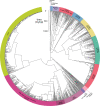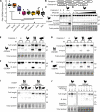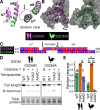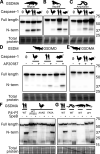This is a preprint.
Caspase-1 activates gasdermin A in non-mammals
- PMID: 37987010
- PMCID: PMC10659411
- DOI: 10.1101/2023.09.28.559989
Caspase-1 activates gasdermin A in non-mammals
Update in
-
Caspase-1 activates gasdermin A in non-mammals.Elife. 2024 Mar 18;12:RP92362. doi: 10.7554/eLife.92362. Elife. 2024. PMID: 38497531 Free PMC article.
Abstract
Gasdermins oligomerize to form pores in the cell membrane, causing regulated lytic cell death called pyroptosis. Mammals encode five gasdermins that can trigger pyroptosis: GSDMA, B, C, D, and E. Caspase and granzyme proteases cleave the linker regions of and activate GSDMB, C, D, and E, but no endogenous activation pathways are yet known for GSDMA. Here, we perform a comprehensive evolutionary analysis of the gasdermin family. A gene duplication of GSDMA in the common ancestor of caecilian amphibians, reptiles and birds gave rise to GSDMA-D in mammals. Uniquely in our tree, amphibian, reptile and bird GSDMA group in a separate clade than mammal GSDMA. Remarkably, GSDMA in numerous bird species contain caspase-1 cleavage sites like YVAD or FASD in the linker. We show that GSDMA from birds, amphibians, and reptiles are all cleaved by caspase-1. Thus, GSDMA was originally cleaved by the host-encoded protease caspase-1. In mammals the caspase-1 cleavage site in GSDMA is disrupted; instead, a new protein, GSDMD, is the target of caspase-1. Mammal caspase-1 uses exosite interactions with the GSDMD C-terminal domain to confer the specificity of this interaction, whereas we show that bird caspase-1 uses a stereotypical tetrapeptide sequence to confer specificity for bird GSDMA. Our results reveal an evolutionarily stable association between caspase-1 and the gasdermin family, albeit a shifting one. Caspase-1 repeatedly changes its target gasdermin over evolutionary time at speciation junctures, initially cleaving GSDME in fish, then GSDMA in amphibians/reptiles/birds, and finally GSDMD in mammals.
Conflict of interest statement
Competing interests: Authors declare that they have no competing interests.
Figures







References
-
- Angosto-Bazarra D, Alarcón-Vila C, Hurtado-Navarro L, Baños MC, Rivers-Auty J, Pelegrín P. Evolutionary Analyses of the Gasdermin Family Suggest Conserved Roles in Infection Response despite Loss of Pore-Forming Functionality. BMC biology. 2022. Jan; 20(1):9. doi: 10.1186/s12915-021-01220-z. - DOI - PMC - PubMed
-
- Bain P, Harr KE. Hematology of Amphibians. In: Schalm’s Veterinary Hematology John Wiley & Sons, Ltd; 2022.p. 1228–1232. doi: 10.1002/9781119500537.ch135. - DOI
Publication types
Grants and funding
LinkOut - more resources
Full Text Sources
